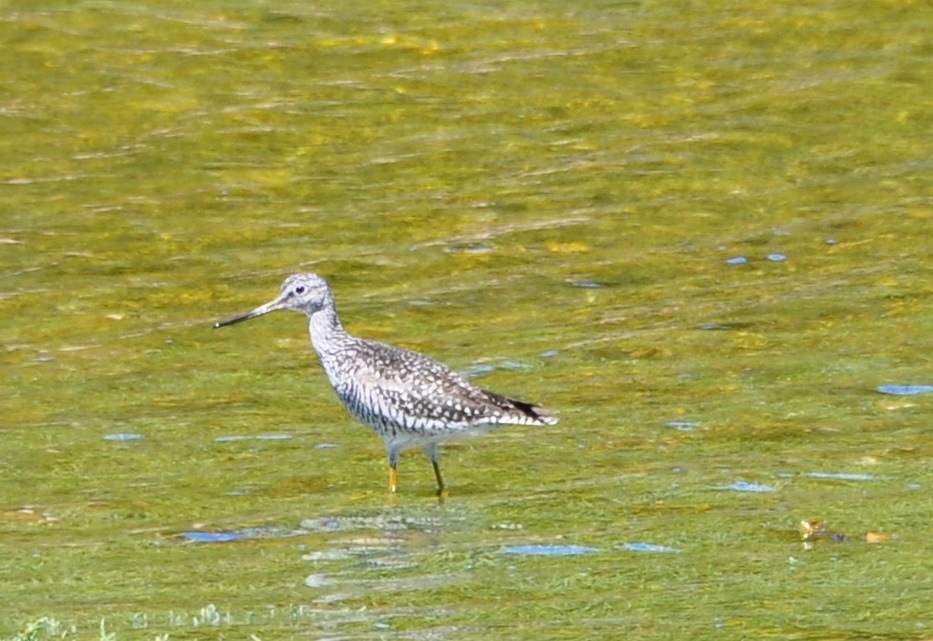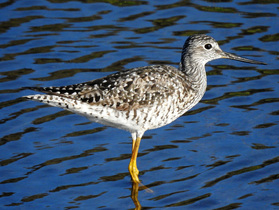Greater yellowlegs • Tringa melanoleuca
Identification
The greater yellowlegs is a tall (to 36 cm), long-legged, relatively long-necked shorebird. Its beak is long and straight or slightly upturned. Its legs are bright yellow, as per its name. Its back, head, and wings are heavily barred and spotted with black and dark brown. Non-breeding birds have a white underside, rump, and tail, and a white or slightly streaked neck. On breeding birds these areas are heavily streaked, spotted, and barred. Breeding birds have all-black bills, while non-breeding birds have two-toned bills.
Click here to listen to the greater yellowleg's songs and calls.
Habitat & Range
The greater yellowlegs is found around tidal flats, lakes, and other wetland areas on the Central Coast during migration months. It nests on muskeg and tundra in areas of northern Canada and Alaska, and winters in wetland habitats in coastal and southern areas of the United States, as well as Mexico, Central America, and South America.
Find more information at the British Columbia Breeding Bird Atlas here.
Similar Species
The lesser yellowlegs (Tringa flavipes) is very similar; the two yellowlegs can be distinguished by size when compared side-by-side, but otherwise correct identification relies on small differences in bill length and shape. The lesser's bill is about the same length as its head, while the greater's bill is significantly longer than its head, and often is slightly upturned. The lesser's bill is more sharply-tipped, and is always black whereas the greater's bill is two-toned when not in breeding season. They exhibit behavioral differences as well: the greater is more active, more wary, and noisier. It skims prey from the surface of the water while swinging the bill from side to side; this is a very characteristic greater yellowlegs behaviour.
The willet (Tringa semipalmata) is also similar in appearance but has black legs. More similar species can be found on the Audubon species page.
Intriguing Info
The greater yellowlegs is a common and widespread bird, but isn't well studied compared to other shorebirds. This is due largely to its low population densities and 'inhospitable' nesting habitats that are full of mosquitoes.
The greater yellowlegs is a tall (to 36 cm), long-legged, relatively long-necked shorebird. Its beak is long and straight or slightly upturned. Its legs are bright yellow, as per its name. Its back, head, and wings are heavily barred and spotted with black and dark brown. Non-breeding birds have a white underside, rump, and tail, and a white or slightly streaked neck. On breeding birds these areas are heavily streaked, spotted, and barred. Breeding birds have all-black bills, while non-breeding birds have two-toned bills.
Click here to listen to the greater yellowleg's songs and calls.
Habitat & Range
The greater yellowlegs is found around tidal flats, lakes, and other wetland areas on the Central Coast during migration months. It nests on muskeg and tundra in areas of northern Canada and Alaska, and winters in wetland habitats in coastal and southern areas of the United States, as well as Mexico, Central America, and South America.
Find more information at the British Columbia Breeding Bird Atlas here.
Similar Species
The lesser yellowlegs (Tringa flavipes) is very similar; the two yellowlegs can be distinguished by size when compared side-by-side, but otherwise correct identification relies on small differences in bill length and shape. The lesser's bill is about the same length as its head, while the greater's bill is significantly longer than its head, and often is slightly upturned. The lesser's bill is more sharply-tipped, and is always black whereas the greater's bill is two-toned when not in breeding season. They exhibit behavioral differences as well: the greater is more active, more wary, and noisier. It skims prey from the surface of the water while swinging the bill from side to side; this is a very characteristic greater yellowlegs behaviour.
The willet (Tringa semipalmata) is also similar in appearance but has black legs. More similar species can be found on the Audubon species page.
Intriguing Info
The greater yellowlegs is a common and widespread bird, but isn't well studied compared to other shorebirds. This is due largely to its low population densities and 'inhospitable' nesting habitats that are full of mosquitoes.
References
Dunn, J. L. and Alderfer, J. (Eds.). (2011). National Geographic Field Guide to the Birds of North America. (6th Ed.). Washington, D.C.: National Geographic Society. Pp. 80-81.
Greater Yellowlegs. The Birds of North America Online (A. Poole, Ed.). Ithaca: Cornell Lab of Ornithology. Retrieved from the Birds of North America Online. Accessed 24/04/2014.
Greater Yellowlegs Tringa melanoleuca. Audubon Birds. National Audubon Society. Accessed 24/04/2014.
Authors and editors of page
Kelly Fretwell and Brian Starzomski (2014).
Dunn, J. L. and Alderfer, J. (Eds.). (2011). National Geographic Field Guide to the Birds of North America. (6th Ed.). Washington, D.C.: National Geographic Society. Pp. 80-81.
Greater Yellowlegs. The Birds of North America Online (A. Poole, Ed.). Ithaca: Cornell Lab of Ornithology. Retrieved from the Birds of North America Online. Accessed 24/04/2014.
Greater Yellowlegs Tringa melanoleuca. Audubon Birds. National Audubon Society. Accessed 24/04/2014.
Authors and editors of page
Kelly Fretwell and Brian Starzomski (2014).






